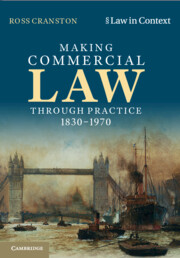Refine search
Actions for selected content:
26946 results in Economic history
Table of Legislation
-
- Book:
- Making Commercial Law Through Practice 1830–1970
- Published online:
- 14 May 2021
- Print publication:
- 27 May 2021, pp xl-xliv
-
- Chapter
- Export citation
Copyright page
-
- Book:
- Making Commercial Law Through Practice 1830–1970
- Published online:
- 14 May 2021
- Print publication:
- 27 May 2021, pp viii-viii
-
- Chapter
- Export citation
2 - The Commodity Markets of London and Liverpool
-
- Book:
- Making Commercial Law Through Practice 1830–1970
- Published online:
- 14 May 2021
- Print publication:
- 27 May 2021, pp 61-126
-
- Chapter
- Export citation
5 - International Commodity Sales
-
- Book:
- Making Commercial Law Through Practice 1830–1970
- Published online:
- 14 May 2021
- Print publication:
- 27 May 2021, pp 294-375
-
- Chapter
- Export citation
4 - Sale, Hire and the Distribution of Manufactured Goods
-
- Book:
- Making Commercial Law Through Practice 1830–1970
- Published online:
- 14 May 2021
- Print publication:
- 27 May 2021, pp 200-293
-
- Chapter
- Export citation
6 - Bank Finance for Trade and Industry
-
- Book:
- Making Commercial Law Through Practice 1830–1970
- Published online:
- 14 May 2021
- Print publication:
- 27 May 2021, pp 376-462
-
- Chapter
- Export citation
Examining the Role of a Private-Order Institution in Global Trade: The Liverpool Cotton Brokers' Association and the Crowning of King Cotton, 1811–1900
-
- Journal:
- Business History Review / Volume 95 / Issue 4 / Winter 2021
- Published online by Cambridge University Press:
- 26 May 2021, pp. 671-702
- Print publication:
- Winter 2021
-
- Article
-
- You have access
- HTML
- Export citation
FISCAL AFTERSHOCKS: TAXES AND CATASTROPHES IN CHILEAN HISTORY
-
- Journal:
- Revista de Historia Economica - Journal of Iberian and Latin American Economic History / Volume 40 / Issue 2 / September 2022
- Published online by Cambridge University Press:
- 24 May 2021, pp. 273-311
- Print publication:
- September 2022
-
- Article
- Export citation
FHR volume 28 issue 1 Cover and Back matter
-
- Journal:
- Financial History Review / Volume 28 / Issue 1 / April 2021
- Published online by Cambridge University Press:
- 24 May 2021, pp. b1-b2
-
- Article
-
- You have access
- Export citation
FHR volume 28 issue 1 Cover and Front matter
-
- Journal:
- Financial History Review / Volume 28 / Issue 1 / April 2021
- Published online by Cambridge University Press:
- 24 May 2021, pp. f1-f2
-
- Article
-
- You have access
- Export citation
The foreign exchange market in Barcelona at the beginning of the fifteenth century
-
- Journal:
- Financial History Review / Volume 28 / Issue 1 / April 2021
- Published online by Cambridge University Press:
- 19 May 2021, pp. 124-151
-
- Article
-
- You have access
- Open access
- HTML
- Export citation

Making Commercial Law Through Practice 1830–1970
-
- Published online:
- 14 May 2021
- Print publication:
- 27 May 2021
Origins of arbitrage
-
- Journal:
- Financial History Review / Volume 28 / Issue 1 / April 2021
- Published online by Cambridge University Press:
- 11 May 2021, pp. 96-123
-
- Article
- Export citation
Chapter 4 - The Dawn of Mass Schooling before 1914
- from Part II - The Long Rise, and Its Causes
-
- Book:
- Making Social Spending Work
- Published online:
- 01 April 2021
- Print publication:
- 08 April 2021, pp 48-62
-
- Chapter
- Export citation
Chapter 5 - Public Education since 1914
- from Part II - The Long Rise, and Its Causes
-
- Book:
- Making Social Spending Work
- Published online:
- 01 April 2021
- Print publication:
- 08 April 2021, pp 63-103
-
- Chapter
- Export citation
Tables
-
- Book:
- Making Social Spending Work
- Published online:
- 01 April 2021
- Print publication:
- 08 April 2021, pp xii-xiii
-
- Chapter
- Export citation
Part II - The Long Rise, and Its Causes
-
- Book:
- Making Social Spending Work
- Published online:
- 01 April 2021
- Print publication:
- 08 April 2021, pp 23-150
-
- Chapter
- Export citation
Chapter 10 - Do the Rich Pay the Poor for All This?
- from Part III - What Effects?
-
- Book:
- Making Social Spending Work
- Published online:
- 01 April 2021
- Print publication:
- 08 April 2021, pp 208-232
-
- Chapter
- Export citation
Chapter 12 - Pensions and the Curse of Long Life
- from Part IV - Confronting Threats
-
- Book:
- Making Social Spending Work
- Published online:
- 01 April 2021
- Print publication:
- 08 April 2021, pp 254-285
-
- Chapter
- Export citation
Chapter 7 - Is the Rest of the World Following a Different Path?
- from Part II - The Long Rise, and Its Causes
-
- Book:
- Making Social Spending Work
- Published online:
- 01 April 2021
- Print publication:
- 08 April 2021, pp 122-150
-
- Chapter
- Export citation
